java注解与反射
发布时间 :
字数:3.5k
阅读 :
文章来源:Java注解与反射——看完这一篇就够了 - Devin-Y - 博客园 (cnblogs.com)
视频:B站_注解与反射
注解(Annotation)与反射(Reflection)
一、注解
1.1、什么是注解
- Annotation是JDK.5.0开始引入的技术
- Annotation的作用:
- 不是程序本身,可以对程序做出解释。(这一点和注释(comment)没有什么区别)
- 可以被其他程序(比如:编译器)读取
- Annotation的格式:
- 注解是以”@注释名”在代码中存在的,还可以添加一些参数值,例如:@SuppressWarnings(value=”unchecked”);
- Annotation在哪里使用?
- 可以附加在package,class,method,field等上面,相当于给它们添加了额外的辅助信息,我们可以通过反射机制编程实现对这些元数据的访问
1
2
3
4
5
6
7
8
|
public class Test01 extends Object{
@Override
public String toString() {
return super.toString();
}
}
|
1.2、内置注解
@Override:定义在java.lang.Override中,此注释只适用于修饰方法,表示一个方法声明打算重写超类中的另一个方法声明;
@Deprecated:定义在java.lang.Deprecated中,此注释可以用于修饰方法、属性、类,表示不鼓励程序员使用这样的元素,通常是因为它很危险或者存在更好的选择。
@SuppressWarnings:定义在java.lang.SuppressWarnings中,用来抑制编译时的警告信息。
- 与上面两个注释有所不同,你需要添加一个参数才能正确使用,这些参数都是已经定义好了的,我们选择使用就行!
1
2
3
4
5
6
7
8
9
10
11
12
13
14
15
16
17
18
19
20
21
22
23
24
25
26
27
| @SuppressWarnings("all")
@SuppressWarnings("unchecked")
@SuppressWarnings(value={"unchecked","Deprecated"})
......
public class Test01 extends Object{
@Override
public String toString() {
return super.toString();
}
@Deprecated
public static void test(){
System.out.println("test-------->Deprecated");
}
@SuppressWarnings("all")
public void test02(){
List list = new ArrayList();
}
public static void main(String[] args) {
test();
}
}
|
1.3、元注解
- 元注解的作用就是负责注解其他注解,Java定义了4个标准的meta-annotation类型,他们被用来提供对其他annotation类型作说明
- 这些类型和它们所支持的类在java.lang.annotation包中可以找到。(@Target,@Retention,@Documented,@Inherited)
- @Target:用于描述注解的使用范围(即:被描述的注解可以用在什么地方)
- @Retention:表示需要什么级别保存该注释信息,用于描述注解的生命周期 (SOURCE<CLASS<RUNTIME)
- @Documented:说明该注解将被包含在javadoc中
- @Inherited:说明子类可以继承父类中的该注解
1
2
3
4
5
6
7
8
9
10
11
12
13
14
15
16
17
18
19
|
public class Test02 {
@MyAnnotation
public void test(){}
}
@Target(value = {ElementType.METHOD,ElementType.TYPE})
@Retention(value = RetentionPolicy.RUNTIME)
@Documented
@Inherited
@interface MyAnnotation{}
|
1.4、自定义注解
- 使用@interface自定义注解时,自动继承了java.lang.annotation.Annotation接口
- 分析:
- @interface用来声明一个注解,格式:public @interface 注解名
- 其中每一个方法实际上是声明了一个配置参数
- 方法的名称就是参数的名称
- 返回值类型就是参数的类型(返回值只能是基本类型,Class,String,enum –>枚举)
- 可以通过default来声明参数的默认值
- 如果只有一个成员变量,一般参数名为value
- 注解元素必须要有值,我们定义注解元素时,经常使用空字符串,0作为默认值
1
2
3
4
5
6
7
8
9
10
11
12
13
14
15
16
17
18
19
20
21
22
23
24
25
26
|
public class Test03 {
@MyAnnotation2(name = "devin",schools = {"农业大学,农大"})
public void test(){}
@MyAnnotation3("devin")
public void test2(){}
}
@Target({ElementType.TYPE,ElementType.METHOD})
@Retention(RetentionPolicy.RUNTIME)
@interface MyAnnotation2{
String name() default "";
int age() default 0;
int id() default -1;
String[] schools();
}
@Target({ElementType.TYPE,ElementType.METHOD})
@Retention(RetentionPolicy.RUNTIME)
@interface MyAnnotation3{
String value();
}
|
二、反射
2.1、反射概述
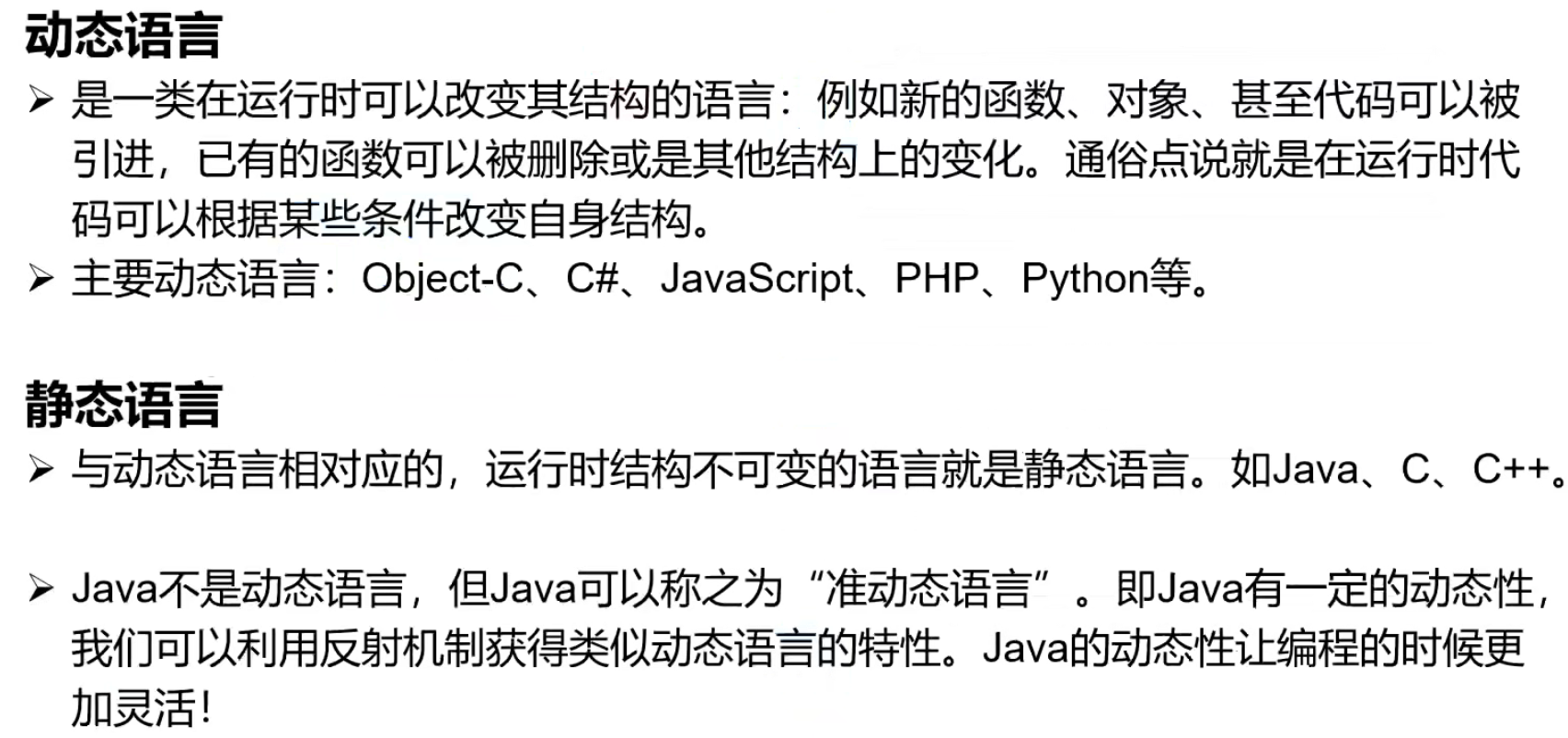
Reflection(反射)是Java被视为动态语言的关键,反射机制允许程序在执行期间借助于Reflection API取得任何类的内部信息,并能直接操作任意对象的内部属性及方法。
1
| Class c = Class.forName("java.lang.String");
|
加载完类之后,在堆内存的方法区中就产生了一个Class类型的对象(一个类只有一个Class对象),这个对象就包含了完整的类的结构信息。我们可以通过这个对象看到类的结构。这个对象就像一面镜子,透过这个镜子看到类的结构,所以,我们形象的称之为:反射!

2.2、获取反射对象
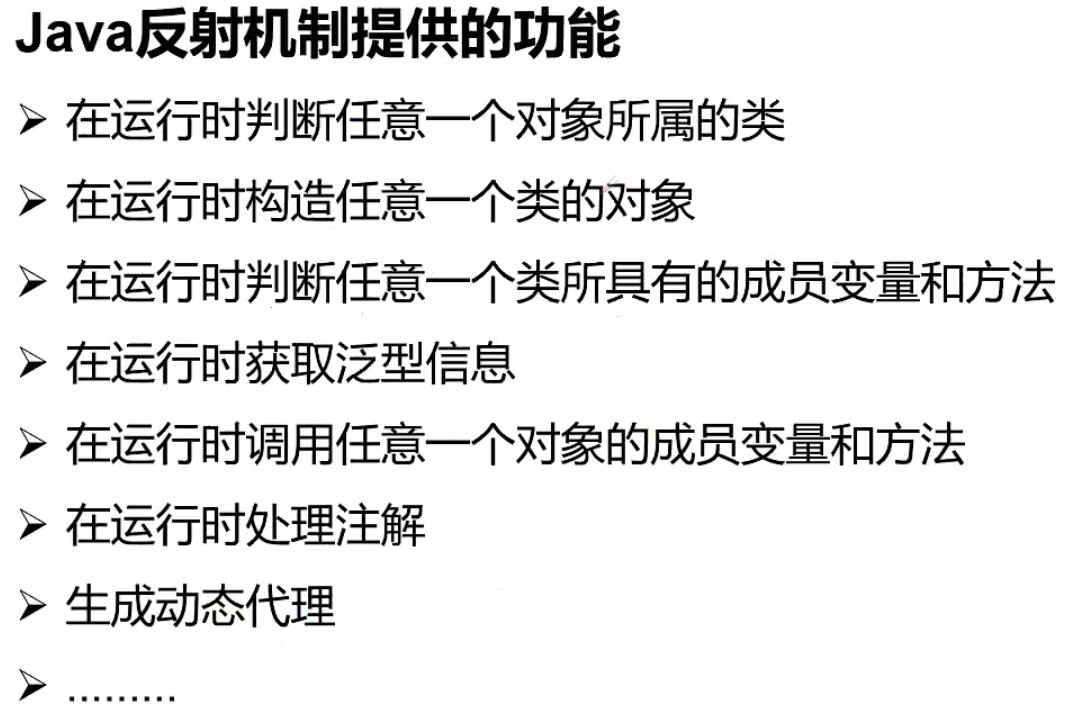
反射的优点和缺点
- 优点:可以实现动态创建对象和编译,体现出很大的灵活性
- 缺点:对性能有影响。使用反射基本上是一种解释操作,可以告诉JVM,我们希望做什么并且满足我们的要求,这类操作总是慢于直接执行相同的操作
反射相关的主要API
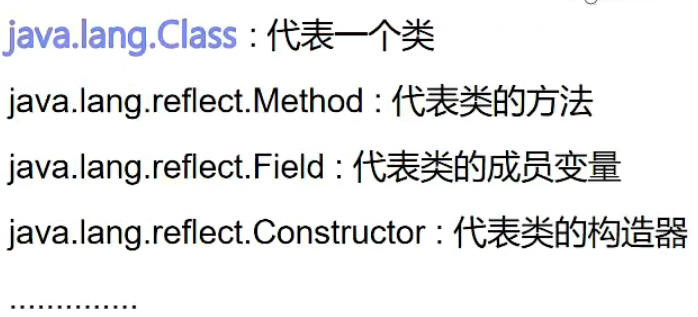
1
2
3
4
5
6
7
8
9
10
11
12
13
14
15
16
17
18
19
20
21
22
23
24
25
26
27
28
29
30
31
32
33
34
35
36
37
38
39
40
41
42
43
44
45
46
47
48
49
50
51
52
53
54
55
56
57
58
59
60
61
62
63
64
65
|
public class Test02 extends Object{
public static void main(String[] args) throws ClassNotFoundException {
Class c1 = Class.forName("注解与反射.reflection.User");
System.out.println(c1);
Class c2 = Class.forName("注解与反射.reflection.User");
Class c3 = Class.forName("注解与反射.reflection.User");
Class c4 = Class.forName("注解与反射.reflection.User");
System.out.println(c2.hashCode());
System.out.println(c3.hashCode());
System.out.println(c4.hashCode());
}
}
class User{
private String name;
private int id;
private int age;
public User() {
}
public User(String name, int id, int age) {
this.name = name;
this.id = id;
this.age = age;
}
public String getName() {
return name;
}
public void setName(String name) {
this.name = name;
}
public int getId() {
return id;
}
public void setId(int id) {
this.id = id;
}
public int getAge() {
return age;
}
public void setAge(int age) {
this.age = age;
}
@Override
public String toString() {
return "User{" +
"name='" + name + '\'' +
", id=" + id +
", age=" + age +
'}';
}
}
|
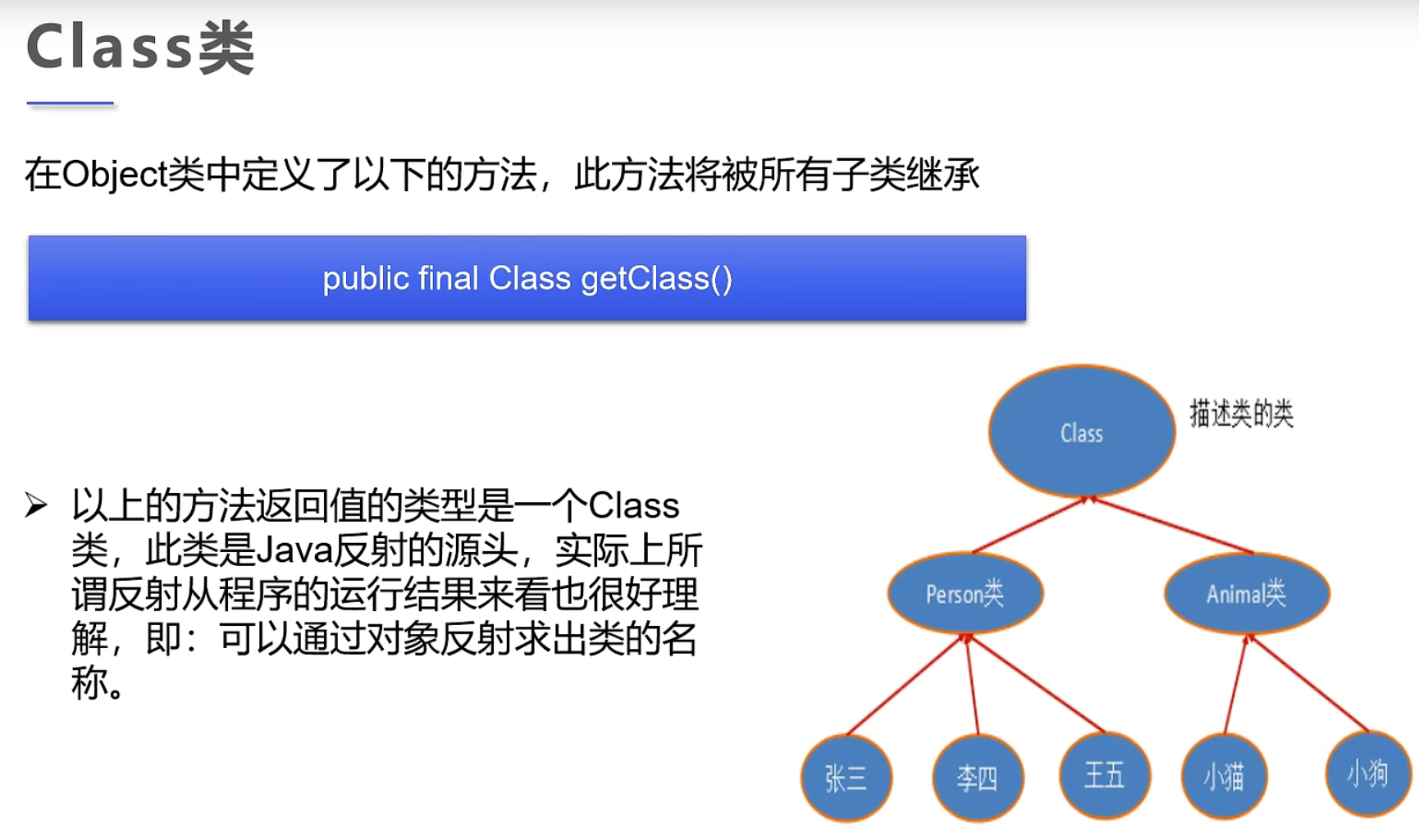
2.3、得到Class类的几种方式
Class类
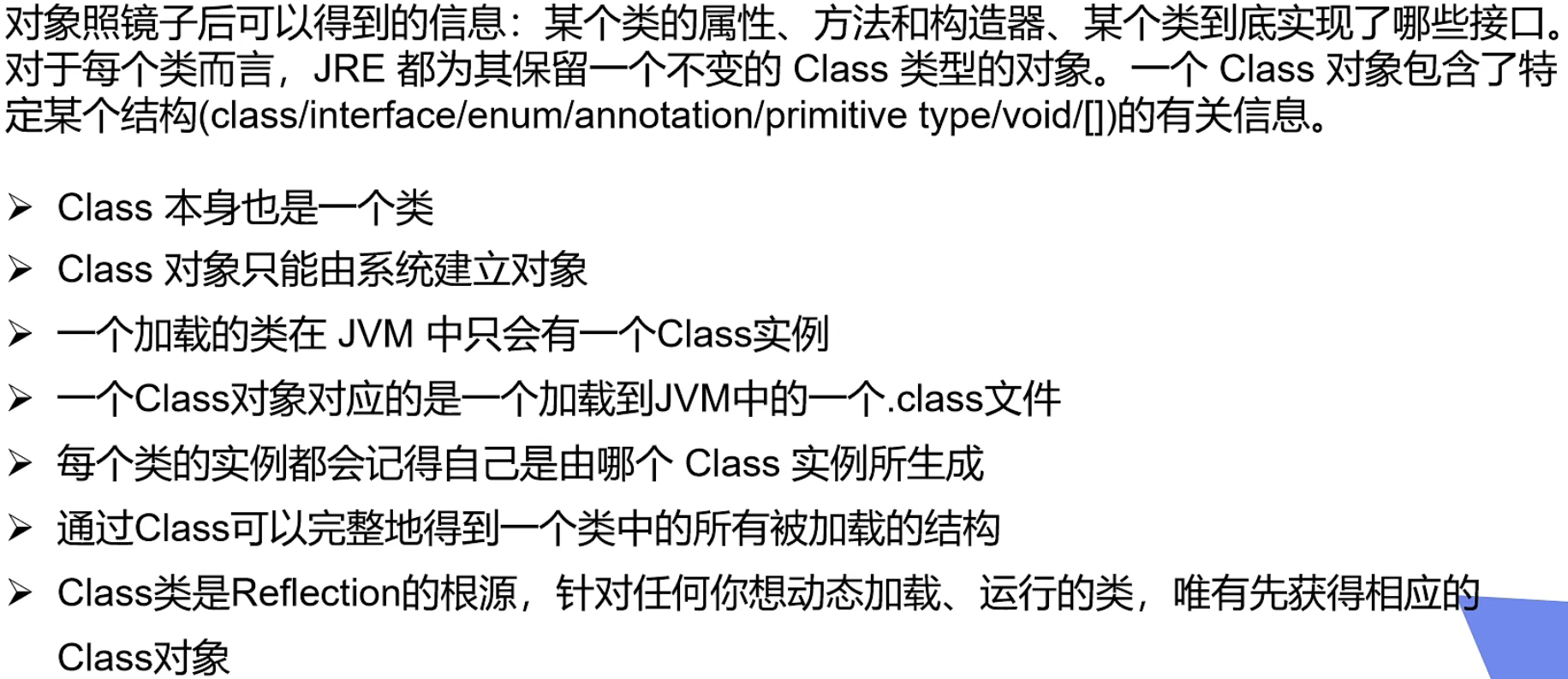
Class对象常用方法
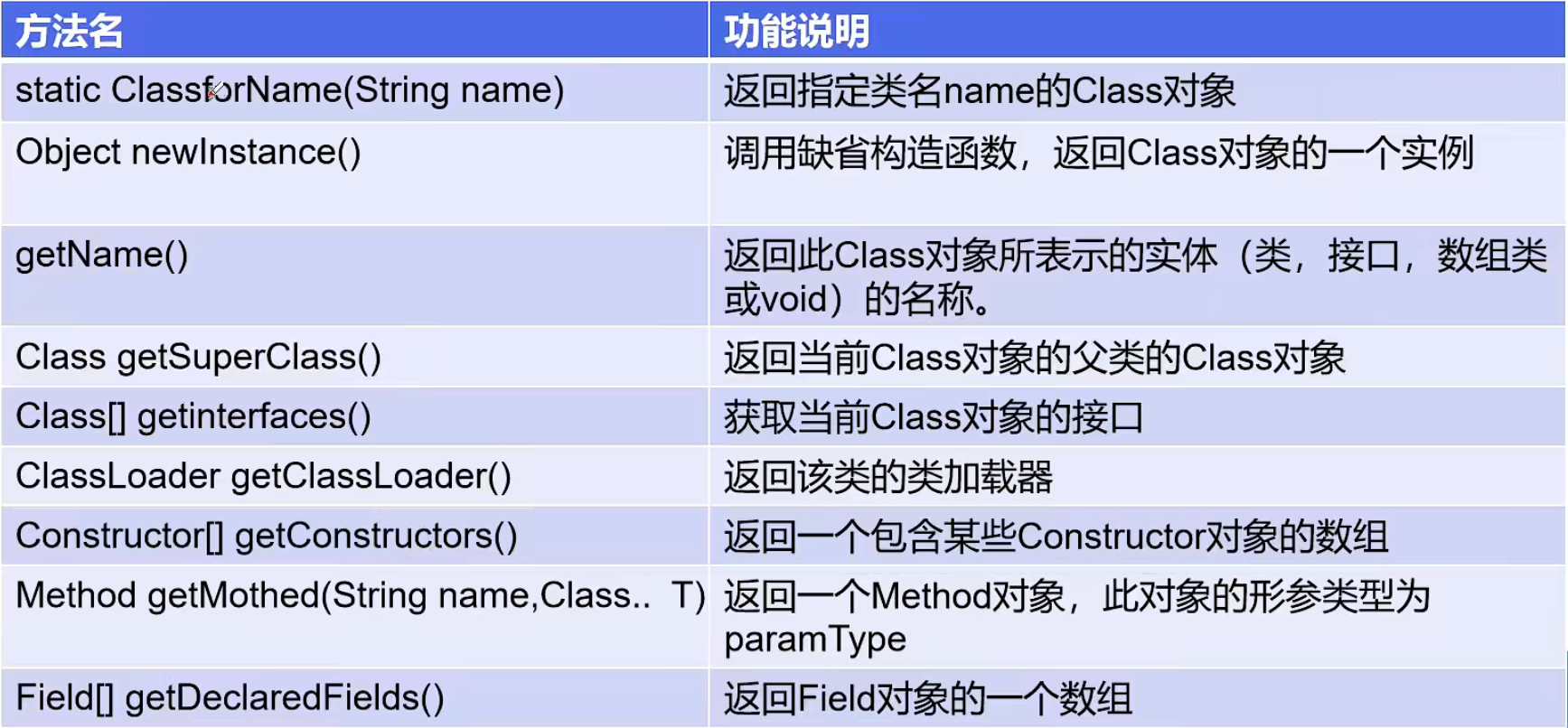
获取Class类的实例
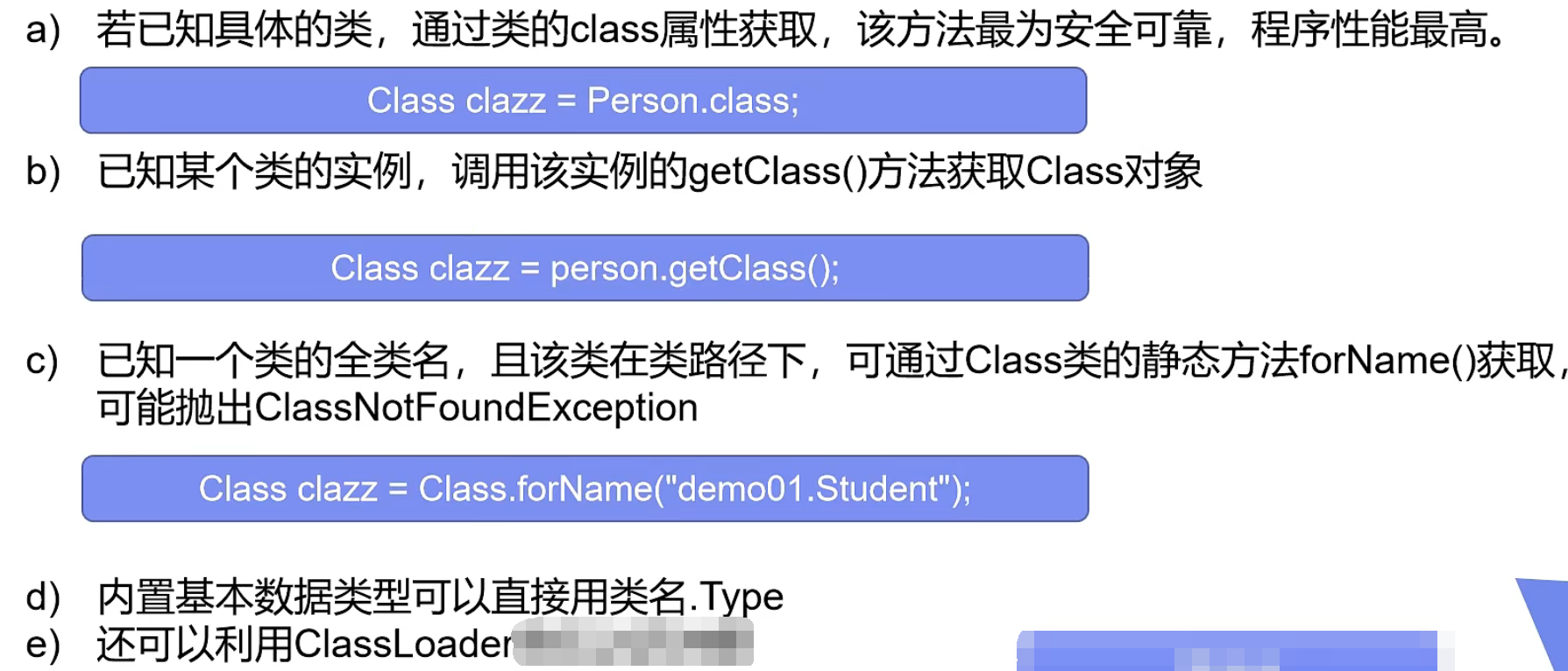
2.4、所有类型的Class对象
那些类型可以有Class对象
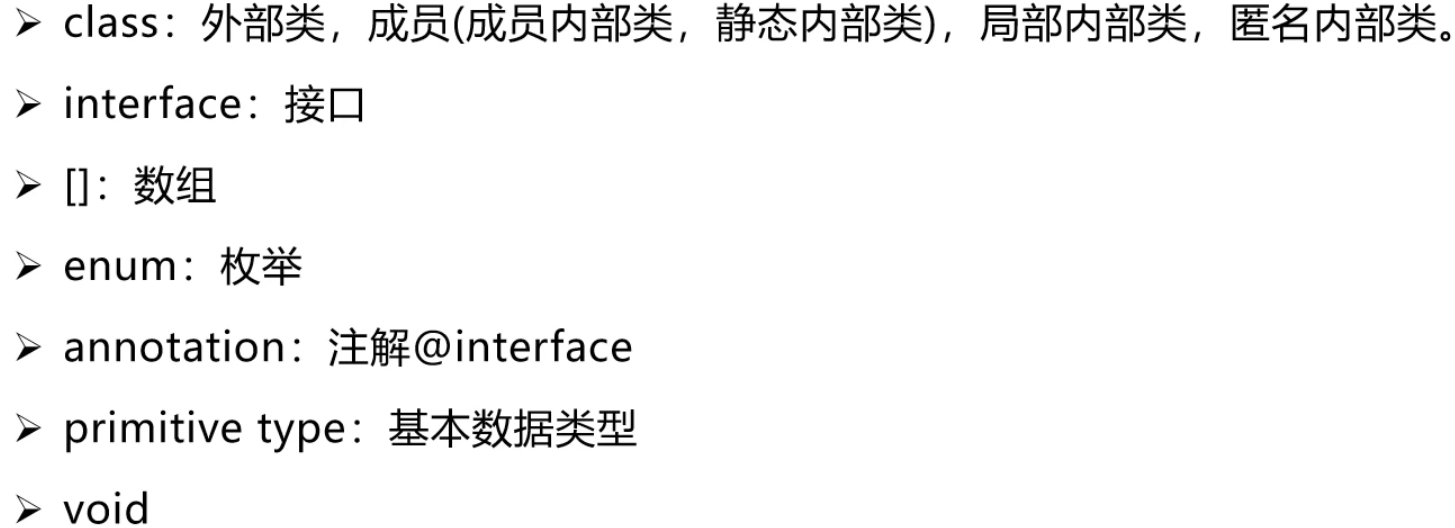
1
2
3
4
5
6
7
8
9
10
11
12
13
14
15
16
17
18
19
20
21
22
23
24
25
26
27
28
29
| public class Test04 {
public static void main(String[] args) {
Class c1 = Object.class;
Class c2 = Comparable.class;
Class c3 = String[].class;
Class c4 = int[][].class;
Class c5 = Override.class;
Class c6 = ElementType.class;
Class c7 = Integer.class;
Class c8 = void.class;
Class c9 = Class.class;
System.out.println(c1);
System.out.println(c2);
System.out.println(c3);
System.out.println(c4);
System.out.println(c5);
System.out.println(c6);
System.out.println(c7);
System.out.println(c8);
System.out.println(c9);
int[] a = new int[10];
int[] b = new int[100];
System.out.println(a.getClass().hashCode());
System.out.println(b.getClass().hashCode());
}
}
|
2.5、类加载内存分析
!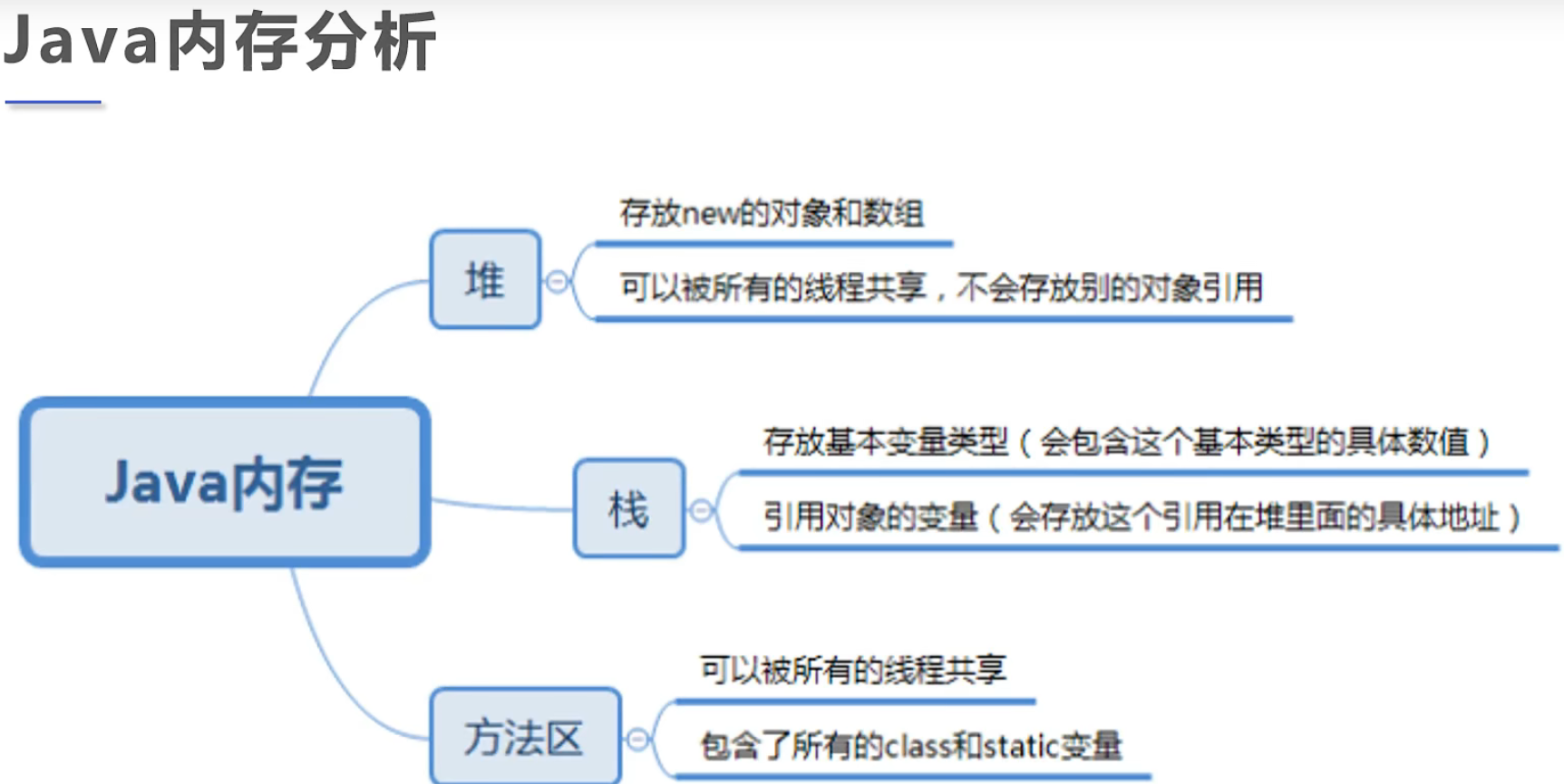
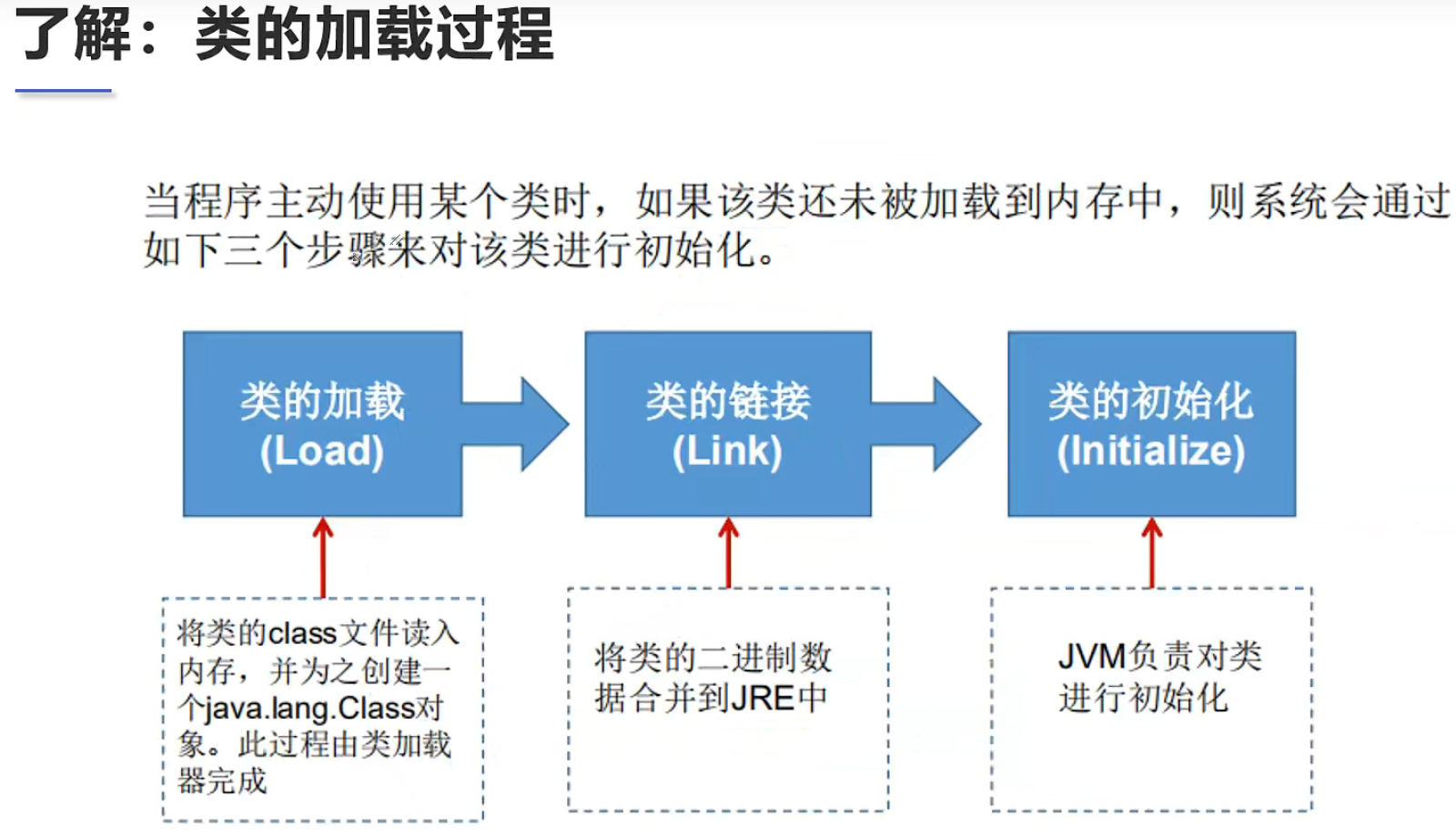
类的加载与ClassLoader的理解
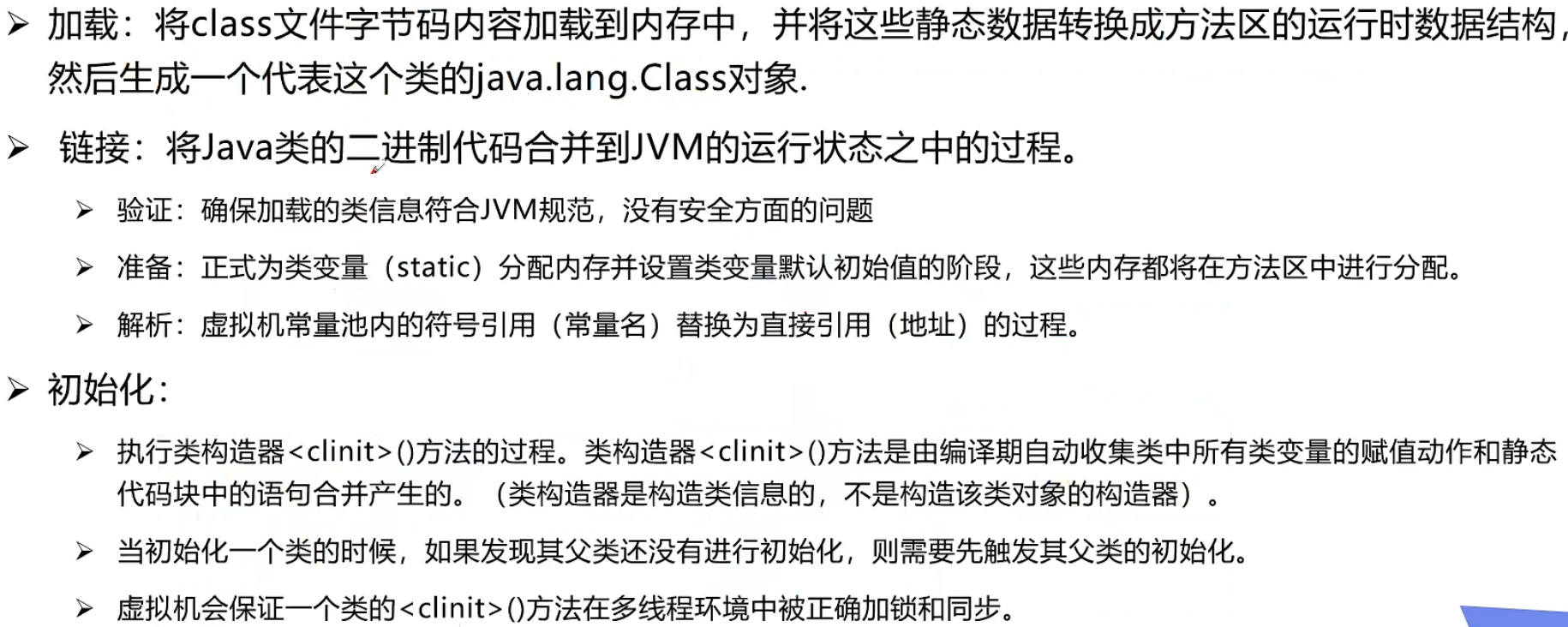
1
2
3
4
5
6
7
8
9
10
11
12
13
14
15
16
17
18
19
20
21
22
23
24
25
26
27
28
29
| public class Test05 {
public static void main(String[] args) {
A a = new A();
System.out.println(A.m);
}
}
class A{
static {
System.out.println("A类静态代码块初始化");
m = 300;
}
static int m = 100;
public A() {
System.out.println("A类无参构造初始化");
}
}
|
2.6、分析类的初始化
什么时候会发生类的初始化?
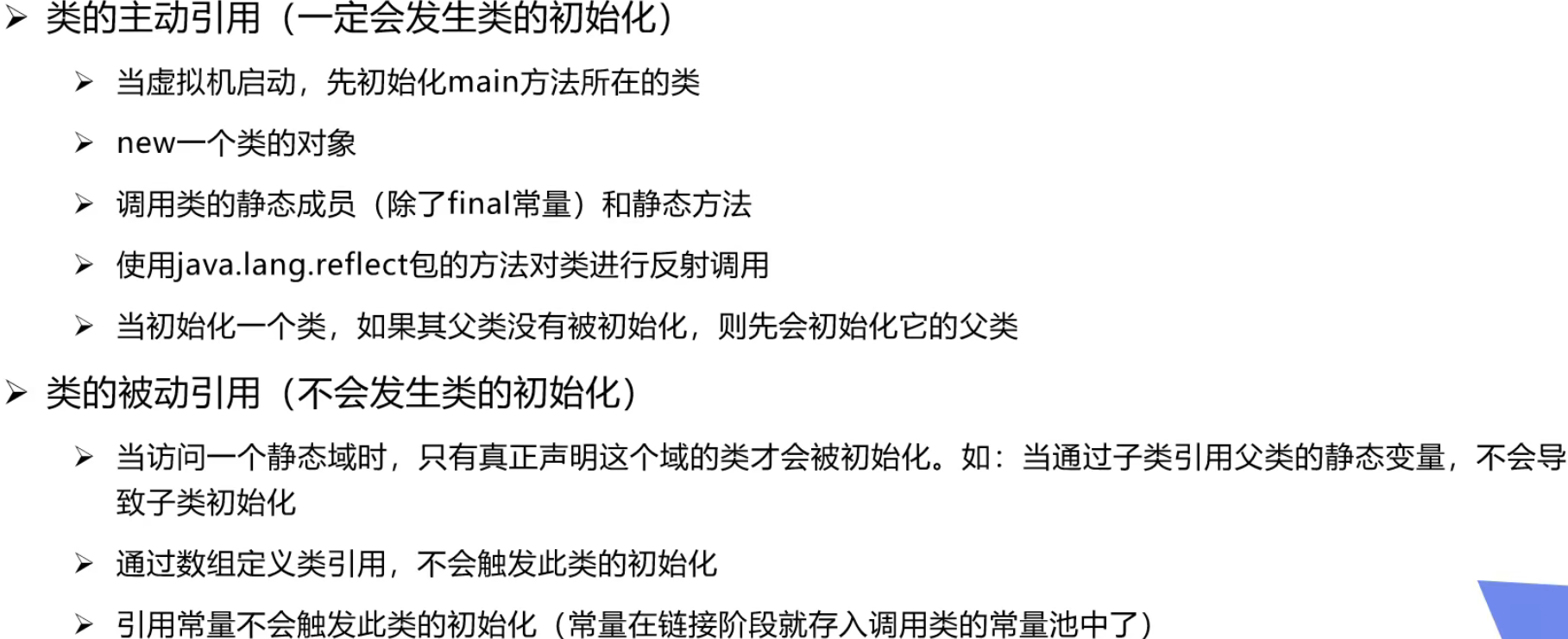
1
2
3
4
5
6
7
8
9
10
11
12
13
14
15
16
17
18
19
20
21
22
23
24
25
26
27
28
29
30
31
32
33
34
35
36
37
|
public class Test06 {
static {
System.out.println("Main被加载");
}
public static void main(String[] args) throws ClassNotFoundException {
System.out.println(Son.M);
}
}
class Father{
static int b = 2;
static {
System.out.println("父类被加载");
}
}
class Son extends Father{
static {
System.out.println("子类被加载");
m = 300;
}
static int m = 100;
static final int M = 1;
}
|
2.7、类加载器
类加载器的作用
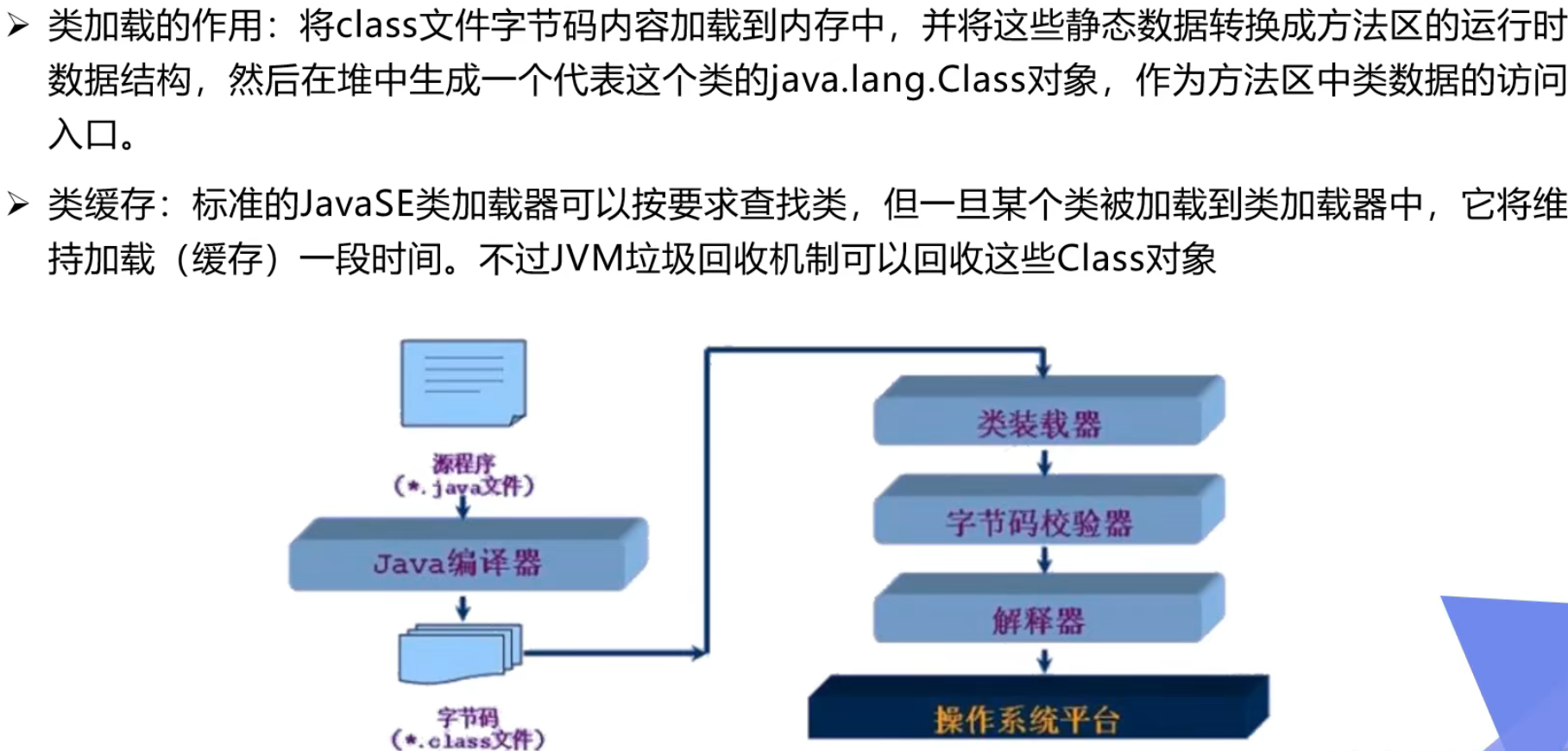
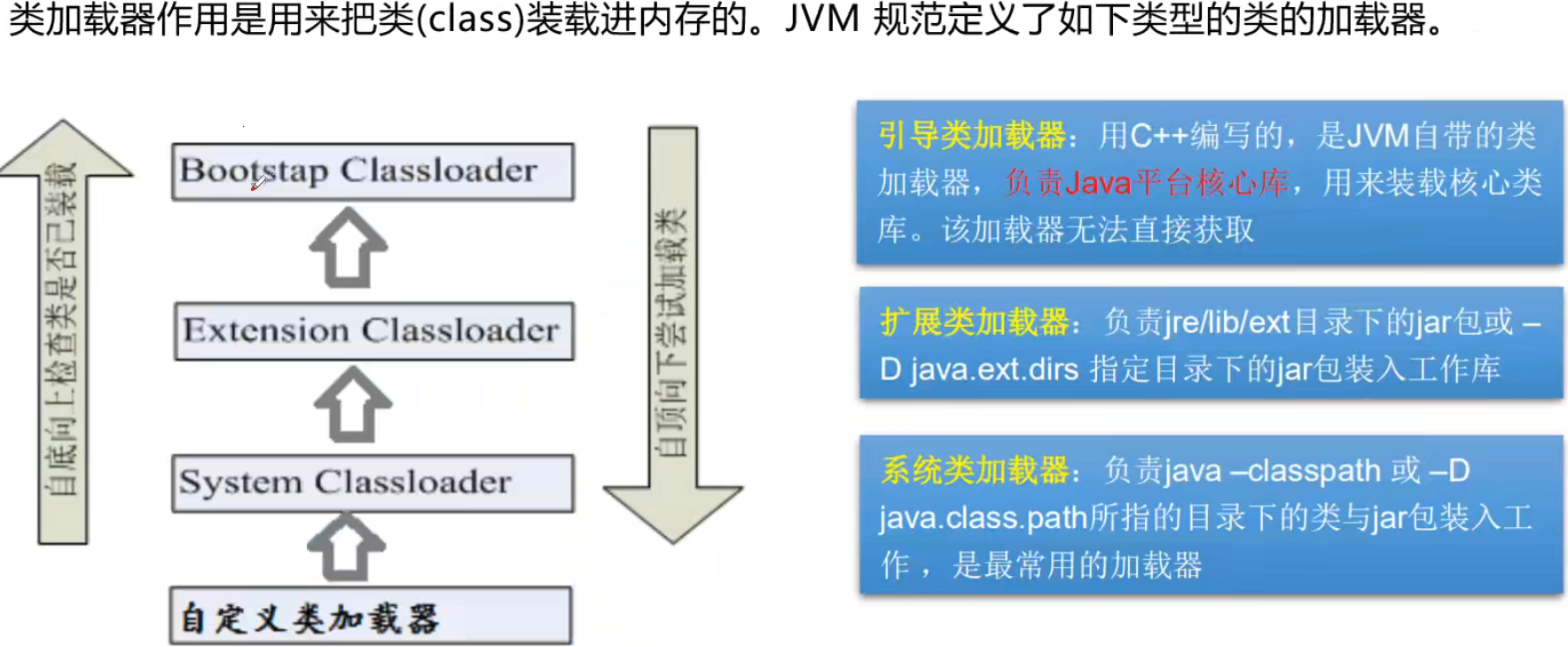
2.8、获取类的运行时结构
获取运行时类的完整结构
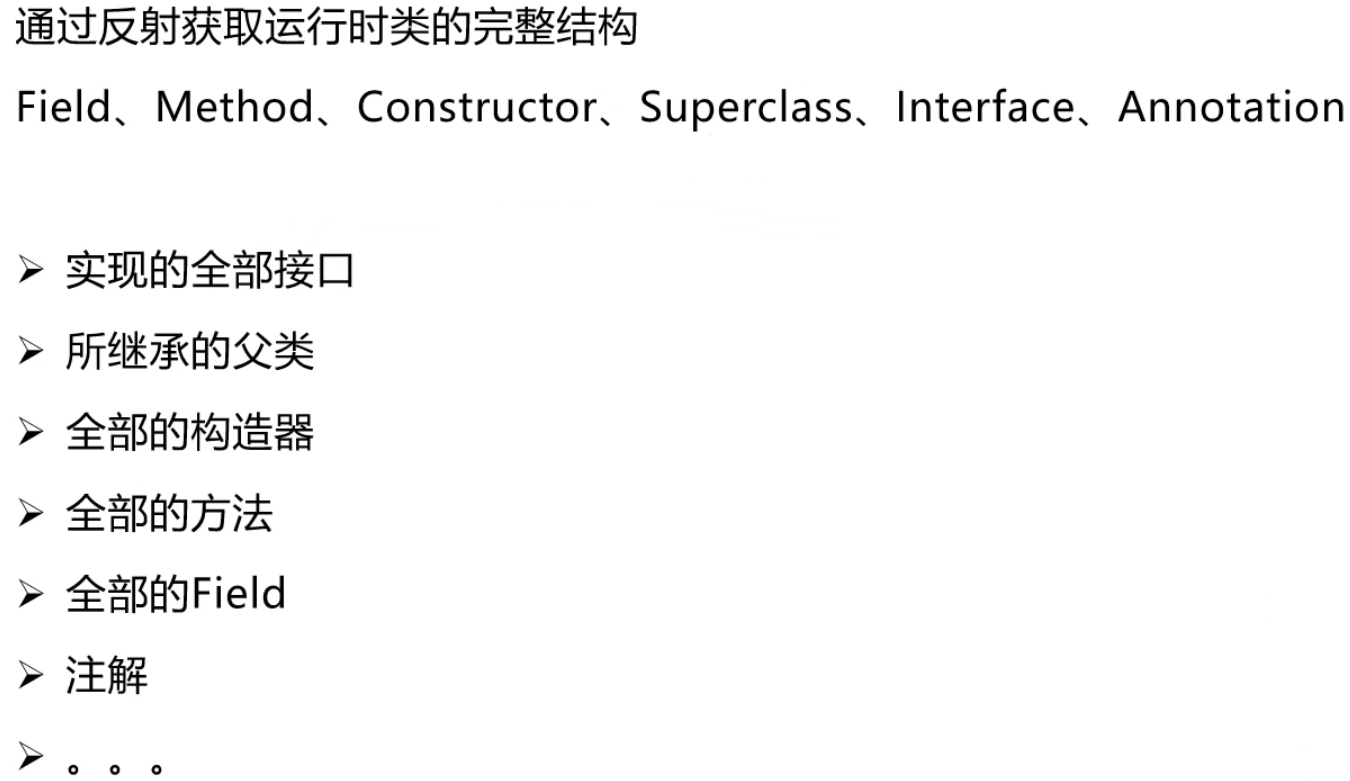
1
2
3
4
5
6
7
8
9
10
11
12
13
14
15
16
17
18
19
20
21
22
23
24
25
26
27
28
29
30
31
32
33
34
35
36
37
38
39
40
41
42
43
44
45
46
47
48
49
50
51
52
53
54
55
56
57
58
59
60
61
|
public class Test08 {
public static void main(String[] args) throws ClassNotFoundException, NoSuchFieldException, NoSuchMethodException {
Class c1 = Class.forName("注解与反射.reflection.User");
System.out.println(c1.getName());
System.out.println(c1.getSimpleName());
System.out.println("============================");
Field[] fields = c1.getFields();
fields = c1.getDeclaredFields();
for (Field field : fields) {
System.out.println(field);
}
Field name = c1.getDeclaredField("name");
System.out.println(name);
System.out.println("============================");
Method[] methods = c1.getMethods();
for (Method method : methods) {
System.out.println("正常的:"+method);
}
methods = c1.getDeclaredMethods();
for (Method method : methods) {
System.out.println("getDeclaredMethods:"+method);
}
System.out.println("============================");
Method getName = c1.getMethod("getName",null);
Method setName = c1.getMethod("setName",String.class);
System.out.println(getName);
System.out.println(setName);
System.out.println("============================");
Constructor[] constructors = c1.getConstructors();
for (Constructor constructor : constructors) {
System.out.println(constructor);
}
constructors = c1.getDeclaredConstructors();
for (Constructor constructor : constructors) {
System.out.println("#"+constructor);
}
System.out.println("============================");
Constructor declaredConstructor = c1.getDeclaredConstructor(String.class, int.class,int.class);
System.out.println("指定的:"+declaredConstructor);
}
}
|
2.9、动态创建对象执行方法
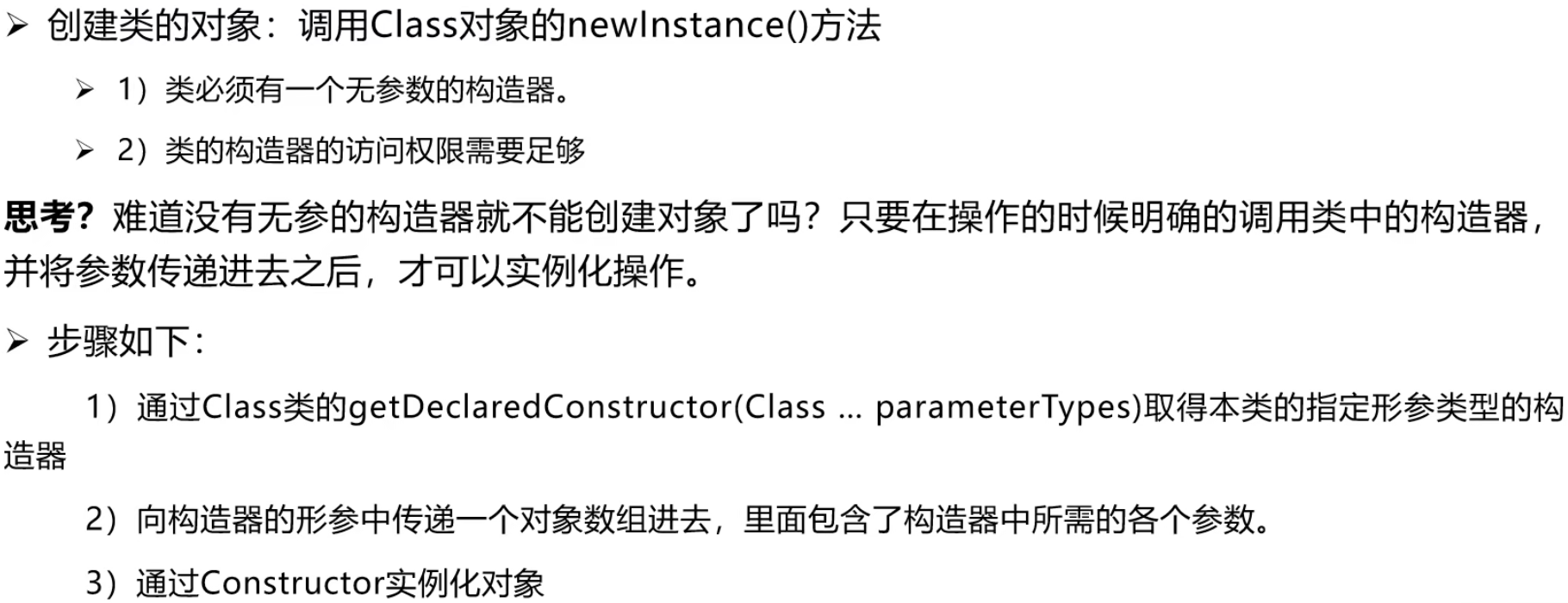
1
2
3
4
5
6
7
8
9
10
11
12
13
14
15
16
17
18
19
20
21
22
23
24
25
26
27
28
29
30
31
32
33
34
|
public class Test09 {
public static void main(String[] args) throws ClassNotFoundException, IllegalAccessException, InstantiationException, NoSuchMethodException, InvocationTargetException, NoSuchFieldException {
Class c1 = Class.forName("注解与反射.reflection.User");
User user3 = (User) c1.newInstance();
Method setName = c1.getDeclaredMethod("setName", String.class);
setName.invoke(user3,"Devin");
System.out.println(user3.getName());
System.out.println("==========================");
User user4 = (User) c1.newInstance();
Field name = c1.getDeclaredField("name");
name.setAccessible(true);
name.set(user4,"Devin2");
System.out.println(user4.getName());
}
}
|
2.10、性能对比分析

1
2
3
4
5
6
7
8
9
10
11
12
13
14
15
16
17
18
19
20
21
22
23
24
25
26
27
28
29
30
31
32
33
34
35
36
37
38
39
40
41
42
43
44
45
46
47
|
public class Test10 {
public static void test01(){
User user = new User();
long startTime = System.currentTimeMillis();
for (int i = 0; i < 1000000000; i++) {
user.getName();
}
long endTime = System.currentTimeMillis();
System.out.println("普通方法执行10亿次:"+(endTime-startTime)+"ms");
}
public static void test02() throws NoSuchMethodException, InvocationTargetException, IllegalAccessException {
User user1 = new User();
Class c1 = user1.getClass();
Method getName = c1.getDeclaredMethod("getName", null);
long startTime = System.currentTimeMillis();
for (int i = 0; i < 1000000000; i++) {
getName.invoke(user1,null);
}
long endTime = System.currentTimeMillis();
System.out.println("反射方式执行10亿次:"+(endTime-startTime)+"ms");
}
public static void test03() throws NoSuchMethodException, InvocationTargetException, IllegalAccessException {
User user3 = new User();
Class c1 = user3.getClass();
Method getName = c1.getDeclaredMethod("getName", null);
getName.setAccessible(true);
long startTime = System.currentTimeMillis();
for (int i = 0; i < 1000000000; i++) {
getName.invoke(user3,null);
}
long endTime = System.currentTimeMillis();
System.out.println("反射方式调用,关闭检测执行10亿次:"+(endTime-startTime)+"ms");
}
public static void main(String[] args) throws NoSuchMethodException, IllegalAccessException, InvocationTargetException {
test01();
test02();
test03();
}
}
|
2.11、获取泛型信息
反射操作泛型
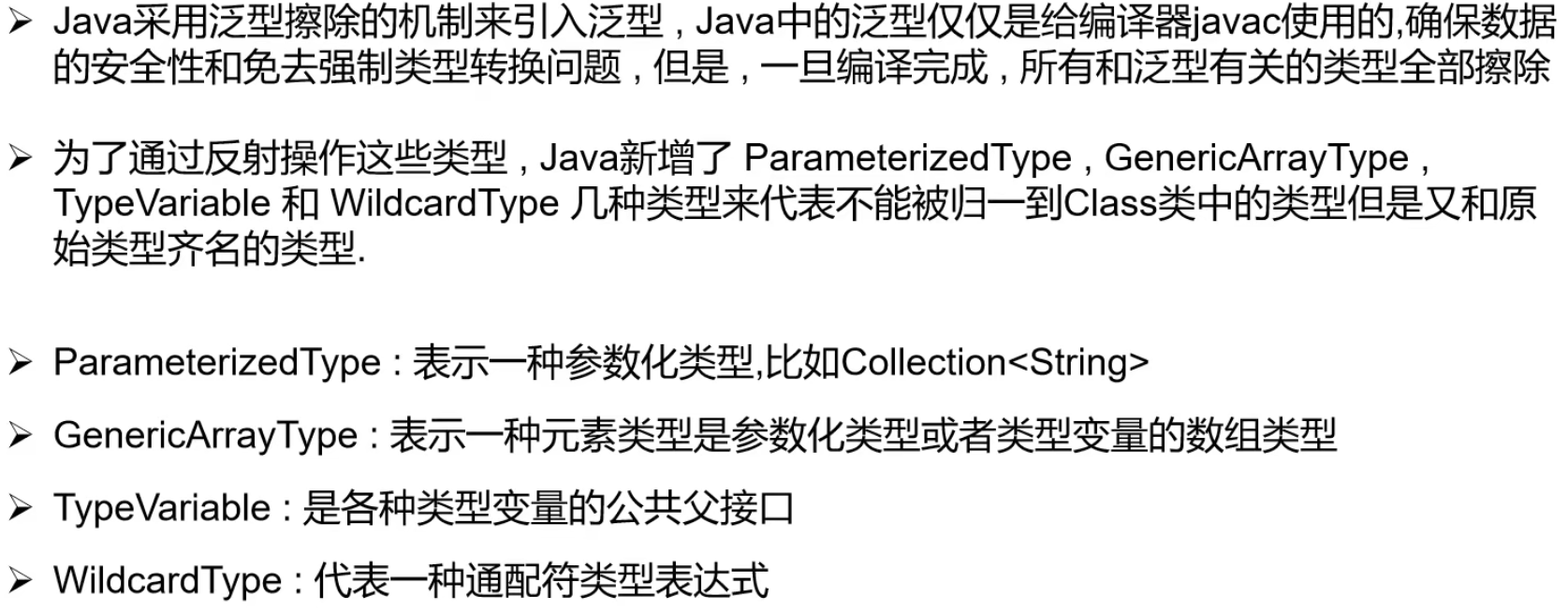
1
2
3
4
5
6
7
8
9
10
11
12
13
14
15
16
17
18
19
20
21
22
23
24
25
26
27
28
29
30
31
32
33
34
35
36
37
38
|
public class Test11 {
public Test11() throws NoSuchMethodException {
}
public void test01(Map<String,User> map, List<User> list){
System.out.println("test01");
}
public Map<String,User> test02(){
System.out.println("test02");
return null;
}
public static void main(String[] args) throws NoSuchMethodException {
Method method = Test11.class.getMethod("test01", Map.class, List.class);
Type[] genericParameterTypes = method.getGenericParameterTypes();
for (Type genericParameterType : genericParameterTypes) {
System.out.println("#"+genericParameterType);
if (genericParameterType instanceof ParameterizedType){
Type[] actualTypeArguments = ((ParameterizedType) genericParameterType).getActualTypeArguments();
for (Type actualTypeArgument : actualTypeArguments) {
System.out.println(actualTypeArgument);
}
}
}
method = Test11.class.getMethod("test02",null);
Type genericReturnType = method.getGenericReturnType();
if (genericReturnType instanceof ParameterizedType){
Type[] actualTypeArguments = ((ParameterizedType) genericReturnType).getActualTypeArguments();
for (Type actualTypeArgument : actualTypeArguments) {
System.out.println(actualTypeArgument);
}
}
}
}
|
2.12、获取注解信息
反射操作注解
1
2
3
4
5
6
7
8
9
10
11
12
13
14
15
16
17
18
19
20
21
22
23
24
25
26
27
28
29
30
31
32
33
34
35
36
37
38
39
40
41
42
43
44
45
46
47
48
49
50
51
52
53
54
55
56
57
58
59
60
61
62
63
64
65
66
67
68
69
70
71
72
73
74
75
76
77
78
79
80
81
82
83
84
85
86
87
88
89
90
91
92
|
public class Test12 {
public static void main(String[] args) throws ClassNotFoundException, NoSuchFieldException {
Class c1 = Class.forName("注解与反射.reflection.Student2");
Annotation[] annotations = c1.getAnnotations();
for (Annotation annotation : annotations) {
System.out.println(annotation);
}
TableDevin tableDevin = (TableDevin) c1.getAnnotation(TableDevin.class);
System.out.println(tableDevin.value());
Field f = c1.getDeclaredField("name");
FileDevin annotation = f.getAnnotation(FileDevin.class);
System.out.println(annotation.columnName());
System.out.println(annotation.type());
System.out.println(annotation.length());
}
}
@TableDevin("db_student")
class Student2{
@FileDevin(columnName = "db_id",type = "int",length = 10)
private int id;
@FileDevin(columnName = "db_age",type = "int",length = 10)
private int age;
@FileDevin(columnName = "db_name",type = "Varchar",length = 3)
private String name;
public Student2() {
}
public Student2(int id, int age, String name) {
this.id = id;
this.age = age;
this.name = name;
}
public int getId() {
return id;
}
public void setId(int id) {
this.id = id;
}
public int getAge() {
return age;
}
public void setAge(int age) {
this.age = age;
}
public String getName() {
return name;
}
public void setName(String name) {
this.name = name;
}
@Override
public String toString() {
return "Student2{" +
"id=" + id +
", age=" + age +
", name='" + name + '\'' +
'}';
}
}
@Target(ElementType.TYPE)
@Retention(RetentionPolicy.RUNTIME)
@interface TableDevin{
String value();
}
@Target(ElementType.FIELD)
@Retention(RetentionPolicy.RUNTIME)
@interface FileDevin{
String columnName();
String type();
int length();
}
|
转载请注明来源,欢迎对文章中的引用来源进行考证,欢迎指出任何有错误或不够清晰的表达。可以在下面评论区评论


















